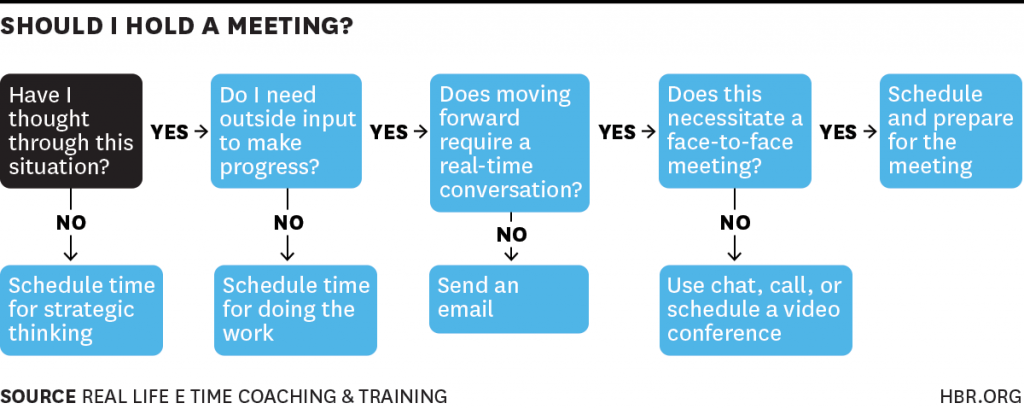A useful flowchart got into my Twitter feed recently. You are supposed to go through it before you call a meeting, to see if you actually need to call a meeting. Which is a great idea, but doesn’t really help if you aren’t the one calling the meeting.
There are ways to have meetings be more productive, or even avoid them entirely, even if you aren’t the one calling them. We can still use the chart (and the HBR.org source article) as we’ll be applying similar methods. More accurately, we’ll try to get the meeting caller to apply them, or allow you to use them.
Depending on your relationship with the meeting caller, sending them the flowchart in a Reply All captioned “do this first and get back to me” is probably not a good strategy. Let’s look for ways to present the flowchart questions differently.
Have You Thought Through This Situation?
Again, I wouldn’t recommend sending that to your client or boss when they ask for a meeting. You’ll have to do some detective work. If the meeting has a solid agenda, you can see what’s up for discussion. You can take each point and run it through the flowchart questions.
If there’s no agenda and no clear purpose for the meeting, then ask for an agenda or clarification about what they want to cover at the meeting. Remind people that you are asking so that you can be prepared for the meeting – don’t make it look like a challenge to their decision to have a meeting.
By asking questions so that you can prepare, yes, you’ll be able to prepare, but you will also force the meeting caller to think about the situation, which may make for a more efficient meeting.
Do You Need Outside Input to Make Progress?
Looking at the agenda, is there anything you can more or less solve and explain without having to discuss it in real time with everyone at the meeting? Note it for the next step.
Does Moving Forward Require a Real-Time Conversation?
So there are some points on the agenda you think can be handled outside the meeting. Is it best explained by email, or do you need to do a phone call, video conference, or screenshare?
If people call a meeting, they’ll usually be more satisfied by a call or one on one meeting than an email.
Does this Require a Meeting?
Anything left that people couldn’t cover on a call? So you might need a meeting… but there might still be ways to make it shorter, or at least have fewer people there for the whole thing.
Does anything on the agenda look like it really only requires a subset of the whole invite list? Consider suggesting to move it to the beginning or end of the meeting, or even breaking it off into a separate meeting. That way, the other people who don’t need to be at that part of the meeting can be productively working on something else. And present it that way: “Can we talk about Jane and Anurag’s project first so that they can leave and have more time to work on it before the weekend,” will make fewer waves than “Can we talk about Jane and Anurag’s project first so that they can leave and we don’t waste their time?”
We might still have a meeting to go to, but at least it will be a shorter meeting, and we have already begun to prepare for it. Over time, we might even get meeting callers to start using these methods without coaxing.
What tricks do you use to get out of meetings? Share them in the comments! I’d prefer if you shared productivity enhancing methods like the ones above, but if you have a hilarious anecdote about going to absurd lengths to shirk responsibility, I won’t stop you.
Finally, the flow chart got into my Twitter feed via Christopher Berry, who is a fountain of brilliant tweets on data, organizational behavior, election behavior, etc., so go follow him.
Summary: How to Get People to Call Fewer Meetings
- If the meeting has a solid agenda, you can see what’s up for discussion.
- If there’s no agenda and no clear purpose for the meeting, ask for an agenda or clarification about what they want to cover. Remind people that you are asking so that you can be prepared – don’t make it look like a challenge to their decision to have a meeting.
- Looking at the agenda or topic, is there anything you can solve and explain without having to discuss it in real time with everyone at the meeting? Note it for the next step.
- Is it best explained by email, or do you need to do a phone call, video conference, or screenshare? If people call a meeting, they’ll usually be more satisfied by a call or one on one meeting than an email..
- Does anything on the agenda look like it really only requires a subset of the whole invite list? Consider suggesting to move it to the beginning or end of the meeting, or even breaking it off into a separate meeting. That way, the people who don’t need to be at that part of the meeting can be productively working on something else.

Leave a Reply